Arrange the terms given below in their orthir order of occurrence describing their ructure and function in the earloy development of the humn embryo: Implantation, cleavage, inner cell mass, trophoblastl, blastomeres, endometrium, morula, blastocyst,
To arrange the terms in their correct order of occurrence during the early development of the human embryo, we can follow these steps:
1. Fertilization: The process begins with fertilization, where the male and female gametes fuse to form a zygote.
2. Cleavage: The zygote undergoes cleavage, which is a series of rapid mitotic divisions that result in the formation of multiple cells.
3. Blastomeres: During cleavage, the individual cells formed are called blastomeres.
4. Morula: As cleavage continues, the cells form a solid ball of cells known as the morula.
5. Blastocyst: The morula develops into a blastocyst, which is a hollow structure with an inner cell mass and an outer layer of cells.
6. Trophoblast: The outer layer of the blastocyst is known as the trophoblast, which will later contribute to the placenta.
7. Inner Cell Mass: The inner cell mass of the blastocyst will eventually develop into the embryo itself.
8. Endometrium: The blastocyst then travels to the uterus and implants into the endometrium, which is the inner lining of the uterus.
9. Implantation: Finally, the process of implantation occurs, where the blastocyst embeds itself into the endometrium, allowing for further development.
Final Order:
1. Cleavage
2. Blastomeres
3. Morula
4. Blastocyst
5. Trophoblast
6. Inner Cell Mass
7. Endometrium
8. Implantation
1. Cleavage
2. Blastomeres
3. Morula
4. Blastocyst
5. Trophoblast
6. Inner Cell Mass
7. Endometrium
8. Implantation
Topper's Solved these Questions
- XII BOARDSBOOK - XII BOARD PREVIOUS YEAR PAPER ENGLISHCHAPTER - XII BOARDSEXERCISE - DELHI BOARD : SET-II SECTION-A
2 Videos
- XII BOARDSBOOK - XII BOARD PREVIOUS YEAR PAPER ENGLISHCHAPTER - XII BOARDSEXERCISE - DELHI BOARD : SET-II SECTION-B
5 Videos
- XII BOARDSBOOK - XII BOARD PREVIOUS YEAR PAPER ENGLISHCHAPTER - XII BOARDSEXERCISE - [SET -I] [Comptt.] SECTION-D
1 Videos
- SAMPLE PAPER 2019BOOK - XII BOARD PREVIOUS YEAR PAPER ENGLISHCHAPTER - SAMPLE PAPER 2019EXERCISE - Section E Part B
3 Videos
Similar Questions
Study the figure given below and answer the questions that follow :
Name the stage of human embryo the figure represents
Identify 'a' in the figure and mention its function.
Mention the fate of the inner cell mass after implantation in the uterus
Where are the stem cells located in this embryo?
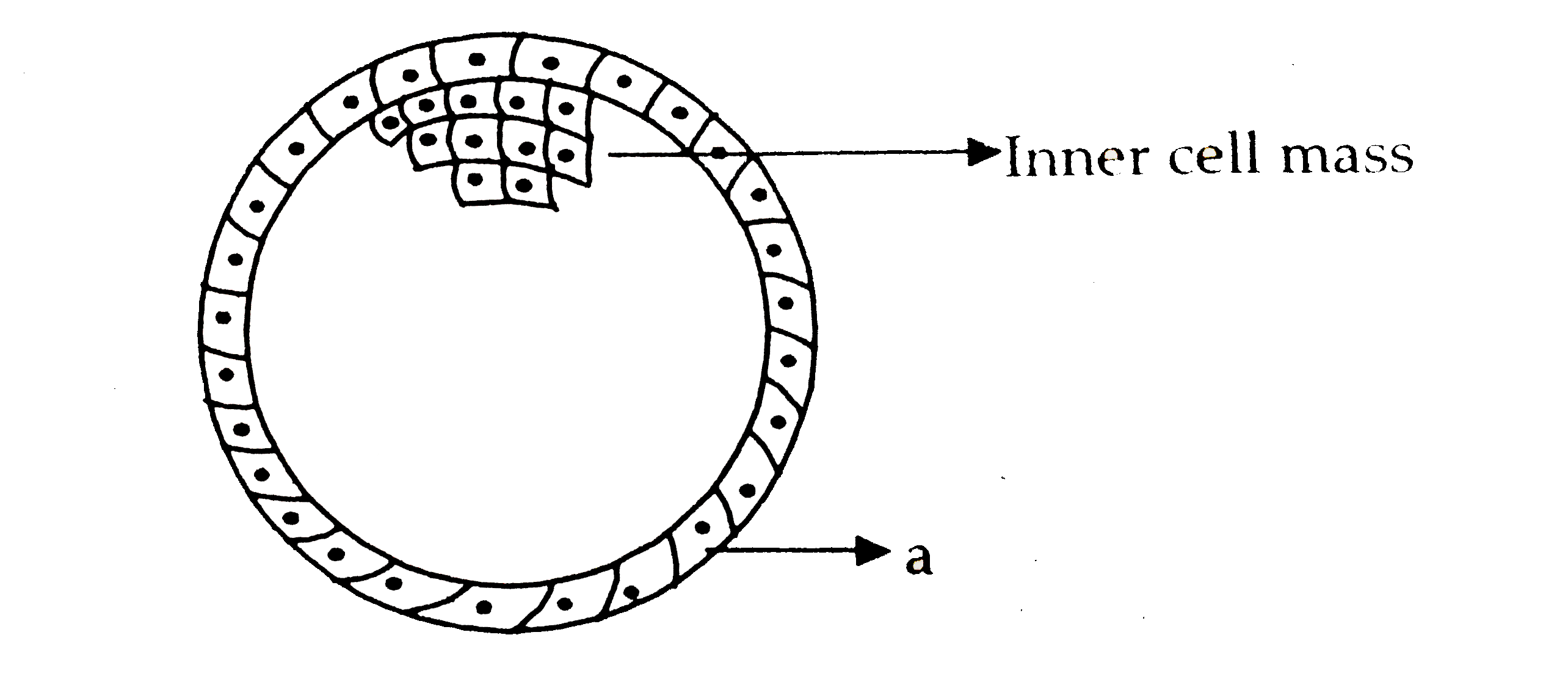
View SolutionStudy the figure given below and answer the questions that follow :
(a)Name the stage of human embryo the figure represents.
(b)Identify 'A' in the figure and mention its function .
( c )Mention the fate of the inner cell mass after implantation in the uterus .
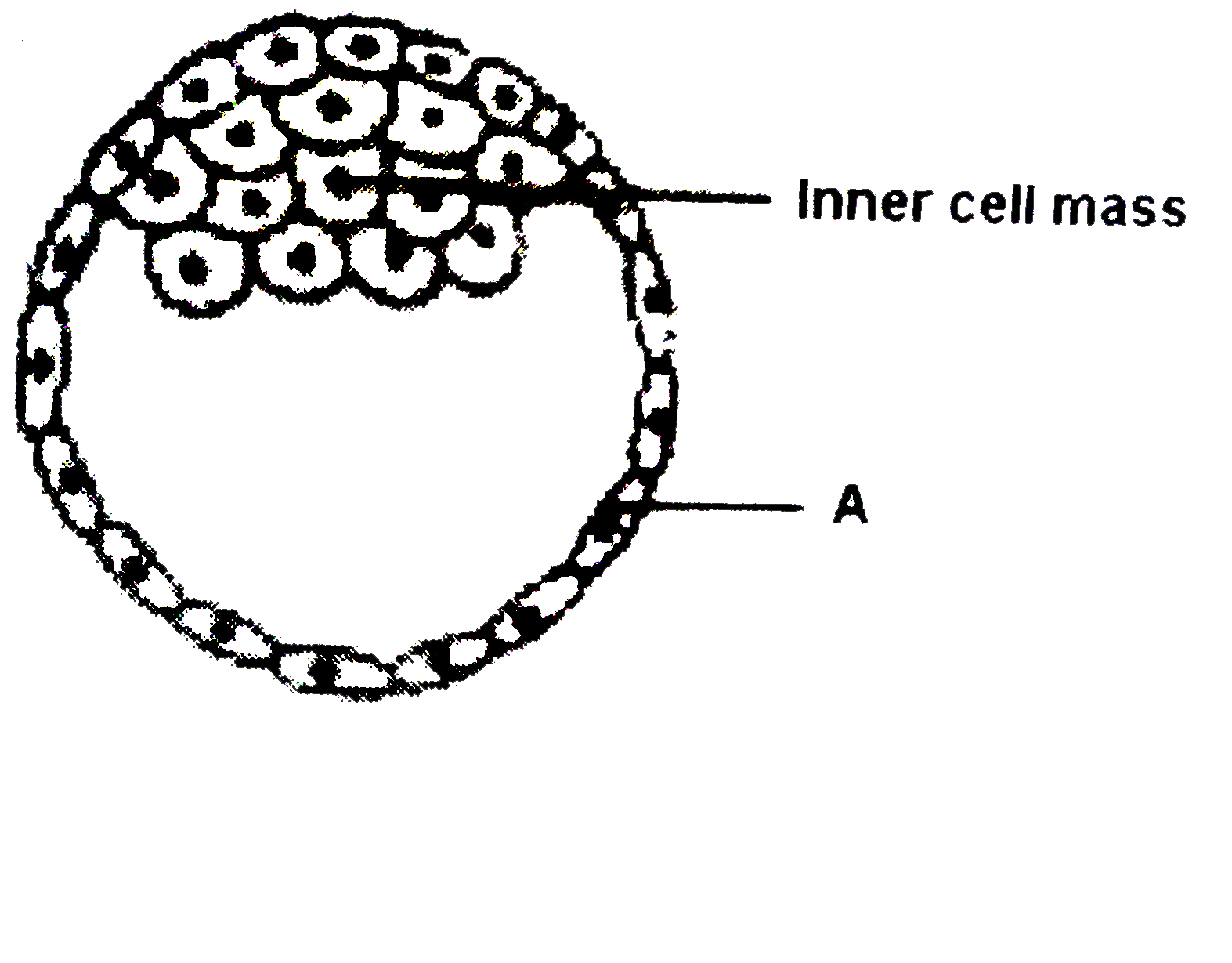
(d)Where are the stem cells located in this embryo ?
View Solution
Knowledge Check
given below are four statements (i)-(iv) reagarding embryonic development in humans.
(i). Cleavage divisions about considerable increase I the mass of protoplasm
(ii). With more cleavage divisions, the resultant blatomeres become smaller and smaller.
(iii). the blastomeres in the blastocyst are arranged into two layers, trophoblast and endometrium.
(iv). Cleavage divisions result in a solid ball of cells called morula.
Which of the above two statemetns are correct?A(i) and (iii)B(ii) and (iv)C(i) and (ii)D(iii) and (iv)Cleavage is the series of rapid mitotic divisions in zygote and forms blastula. The 2, 4, 8, 16 daughter cells are called blastomere. Embryo with 64 blastomere is known as blastocyst and has blastocoel cavity. Blastocyst gets implanted in uterine wall and leads to pregnancy.
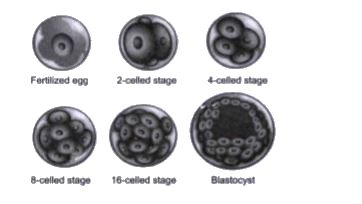
The cells within the inner cell mass that possess the ability to give rise to the entire organism are called:Aplacental cellsBstem cellsCmother cellsDzygoteGiven below are four statements each with one or two blanks. Select the option which correctly fills up the blanks in any two statements.
(A). The embryo with 8 to 16 blastomeres is called a (i)._____
(B). Embedding of the (i)._____ in the endometrium of the uterus is called implantation and it leads to (ii). ______
(C). After implantation finger like projections appear on the trophoblast called (i)._____ which are surrounded by the (ii)._____ abnd maternal blood.
(D). Inner cell mass contains certain cells called (i)._____ cells which have the potency to give rise to all the tissues and organs.A(A)-(i) blastula, (C)-(i) chorionic villi, (ii)-uterine tissueB(B)-(i) blastocyst, (ii) pregnancy, (D)-(i) stemC(A)-(i) morula, (D)-(i) sertliD(B)-(i) morula, (ii) parturition, (C)-(i) fimbriae, (ii)-embryonic tissue
Given below are five groups of terms. In each group arrange and rewrite the terms in the correct order so as to be in a logical sequence.
For example:
Question : Implantation, Parturition, Ovulation, Gestation, Fertilization.
Answer: Ovulation, Fertilization, Implantation, Gestation, Parturition.
Spongy cells, Upper epidermis, Stoma, Palisade tissue, Substomatal space.
View SolutionZygote undergoes cleavage while moving through the isthmus of the oviduct towards the uterus and forms daughter cells called blastomeres. The embryo with 8 to 16 blastomeres is called a ____A_____which continues to divide to form ____B_____ in uterus. The blastomeres in the____B_____are arranged into an outer layer called____C_____and an inner group of cells called the inner cell mass.
View SolutionCleavage is the series of rapid mitotic divisions in zygote and forms blastula. The 2, 4, 8, 16 daughter cells are called blastomere. Embryo with 64 blastomere is known as blastocyst and has blastocoel cavity. Blastocyst gets implanted in uterine wall and leads to pregnancy.
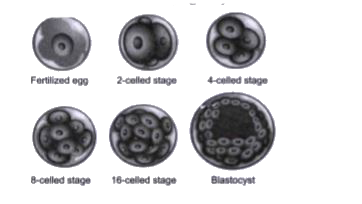
Solid mass of cells with 16 blastomere is called:
View SolutionCleavage is the series of rapid mitotic divisions in zygote and forms blastula. The 2, 4, 8, 16 daughter cells are called blastomere. Embryo with 64 blastomere is known as blastocyst and has blastocoel cavity. Blastocyst gets implanted in uterine wall and leads to pregnancy.
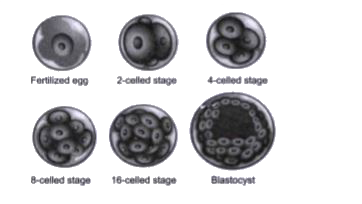
Correct sequence of various structures formed during embryonic development:
View SolutionCleavage is the series of rapid mitotic divisions in zygote and forms blastula. The 2, 4, 8, 16 daughter cells are called blastomere. Embryo with 64 blastomere is known as blastocyst and has blastocoel cavity. Blastocyst gets implanted in uterine wall and leads to pregnancy.

The solid mass of 8-16 cells formed from zygote after successive mitotic division is called:
View Solution
